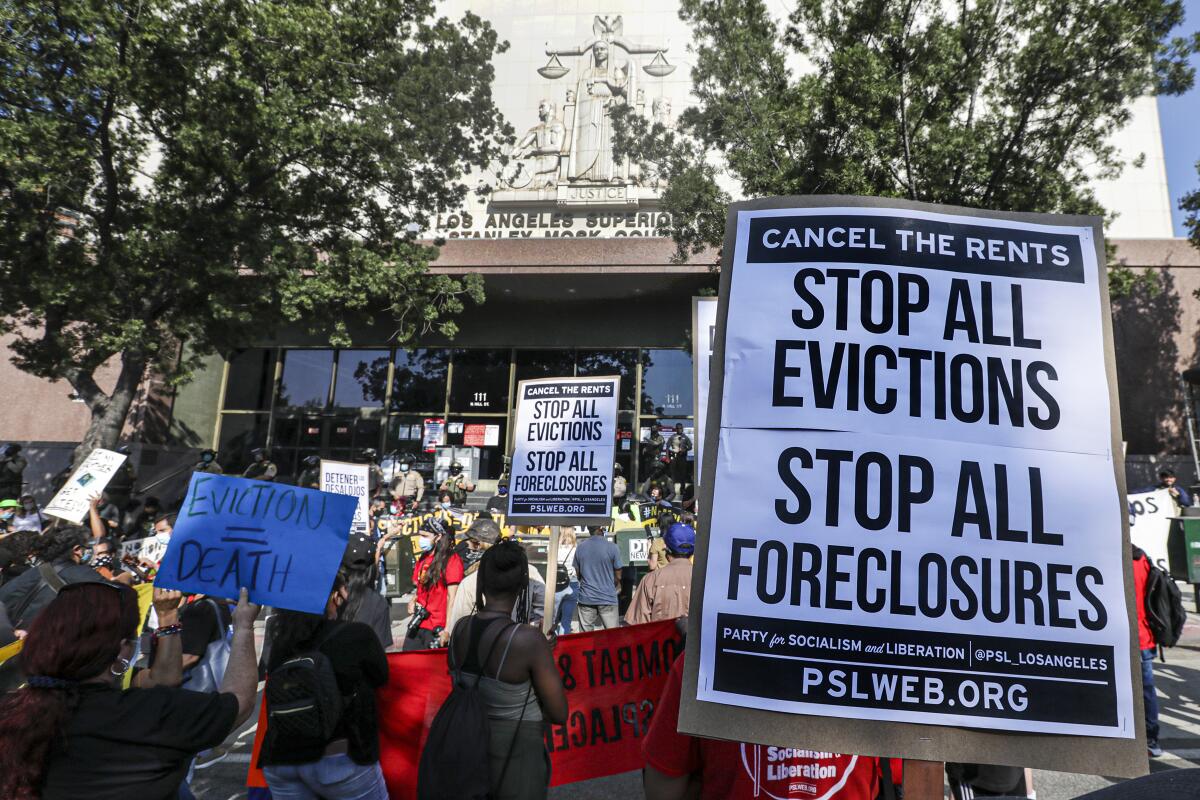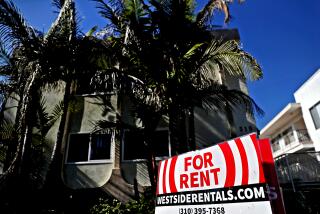Eviction cases in California projected to double

- Share via
California courts are bracing for eviction cases to double over the next year as pandemic-related financial woes deepen for thousands of renters across the state.
Landlords are expected to file 240,000 new eviction cases — twice what occurs in a typical year, according to estimates by state court officials. The projection takes into account the looming expiration of state eviction protections, which end in late January.
While Gov. Gavin Newsom hopes to extend the renter safeguards, he’s also asked the Legislature to increase the judicial system’s funding so that courts can prepare for an eventual surge in evictions.
“If cases in fact do not double, and we certainly hope they won’t, these funds will be returned,” Newsom spokesman Jesse Melgar said.
The pandemic has battered low-income tenants across the state who had already needed to dedicate significant portions of their income to cover California’s high housing costs. Many low-income renters work in food service and other sectors that have faced severe wage and job losses because of COVID-19 and live in neighborhoods with disproportionately high rates of coronavirus infections.
By June of last year, workers in nearly 1 million renter households in the state had lost their jobs due to the COVID-19 pandemic, according to a report from UC Berkeley’s Terner Center for Housing Innovation, one of many analyses warning of a massive wave of evictions due to the pandemic. Last month, a U.S. Census Bureau survey found that more than 1.9 million adult Californians living in rental homes reported being behind on their rent.
Many tenants have been able to stay in their homes thus far with the help of a patchwork of renter protection laws passed since spring.
Federal protections allow tenants to avoid eviction if they notify their landlords, though all back rent is due immediately once the program expires. President Biden, on his first day in office Wednesday, signed an executive order extending the rules through March.
State law protects California tenants if they are able to pay at least a quarter of the rent they’ve owed through Jan. 31, though landlords can sue for whatever debt still exists. Newsom and lawmakers are negotiating a potential extension to the state eviction protections. Additionally, some local governments across the state, including the city and county of Los Angeles, have approved similar policies.
The safeguards have contributed to a sharp drop in eviction cases in Los Angeles.
About 14,000 residential eviction cases were filed in Los Angeles Superior Court in 2020, a 66% decrease from the previous year, according to data collected by Kyle Nelson, a UCLA doctoral student who researches evictions.
The pace of filings shows how anti-eviction rules have guided landlords, Nelson said. Last January and February, landlords filed about 3,300 cases a month, a rate similar to 2019. Yet starting in March, when pandemic-related stay-at-home orders and initial eviction protections went into effect, the numbers began dropping significantly, and hovered around 350 a month through the summer. Filings started rising again to about 1,000 a month starting in October after the court system rescinded its own rules that had blocked all eviction cases except for those deemed urgent.
Tenant advocates say the recent increase in eviction filings — though still far from levels feared at the beginning of the pandemic — signals that renter protections could be made stronger.
“What we see in these numbers is just devastating,” Nelson said. “It doesn’t confirm the scale that advocates were worried about. But it absolutely does confirm the fact that we’re just not doing enough to address evictions.”
For landlords, however, the eviction rules are just one of many problems.
Tenants are abandoning leases and many landlords worry they won’t be able to recover overdue rent, said Daniel Yukelson, executive director of the Apartment Assn. of Greater Los Angeles. Additionally, the L.A. rental market has dipped, with median two-bedroom rents in the region now at $1,990, nearly 10% lower than last year, according to rental website Apartment List.
With rents going unpaid and vacancy rates ticking up, landlords are having troubles paying their mortgages and other bills, Yukelson said.
“I am hearing more and more from property owners that are concerned about holding on, that have received notices of default and have had to dip into emergency funds or retirement savings to keep their rental properties afloat,” Yukelson said.
The rent declines in large cities are the among many reasons why it’s hard to estimate how many evictions may occur once pandemic-related protections go away.
Even more than in Los Angeles, median rents have plummeted in large Bay Area cities and landlords may not want to evict their tenants who owe rent out of fear that they won’t be able to find someone else, said Carolina Reid, a coauthor of the UC Berkeley report. On the other hand, L.A. and Bay Area landlords with longtime rent-controlled tenants might have an incentive to evict them so their apartments can go back on the market at higher prices.
Ultimately, she said, direct rental assistance is the best strategy to keep tenants housed while also allowing landlords to pay their bills.
“There were already a lot of households one shock away from housing insecurity,” said Reid, the Terner Center’s faculty research director. “COVID’s been a huge shock. I don’t think we get out of that easily or cheaply.”
Some money is now on the way and there’s evidence other government benefits have been working. California tenants and landlords are in line to receive $2.6 billion in rental assistance from the coronavirus stimulus package approved by Congress last month. And expanded federal unemployment benefits, which provide a weekly subsidy beyond regular state payments to those who’ve lost jobs, also have been keeping tenants afloat, according to research released this week from the state’s nonpartisan Legislative Analyst’s Office.
The increased unemployment benefits have been so consequential that the analyst’s office estimates the total amount California tenants owe landlords could be as low as $400 million. If true, the forthcoming rental assistance will more than cover that amount once the money gets in tenants and landlords’ pockets.
More to Read
Sign up for Essential California
The most important California stories and recommendations in your inbox every morning.
You may occasionally receive promotional content from the Los Angeles Times.







